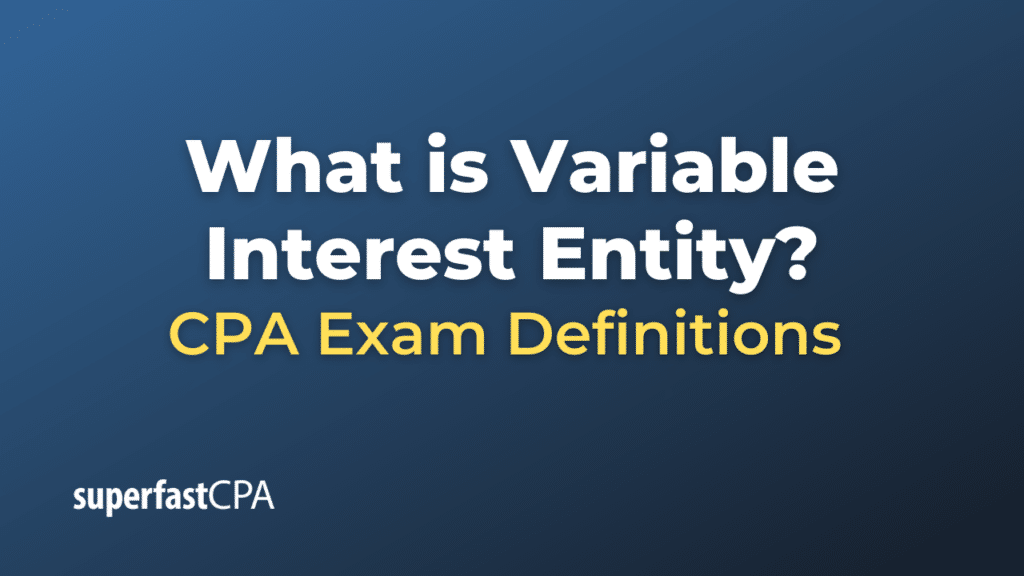Variable Interest Entity
A Variable Interest Entity (VIE) is a legal entity in which an investor holds a controlling interest that is not based on the majority of voting rights. The concept was introduced by the Financial Accounting Standards Board (FASB) in the United States to address loopholes in accounting for special purpose entities. The rules surrounding VIEs are specified in the U.S. Generally Accepted Accounting Principles (GAAP), particularly in the Accounting Standards Codification (ASC) 810.
The idea is that if a company exerts control over another entity but does not have a majority of voting rights (or perhaps none at all), it may still have to consolidate that entity’s financial statements as if it were a traditional subsidiary. The need to consolidate is based on various qualitative and quantitative factors that demonstrate control.
Criteria for a VIE:
A company is considered a VIE if it meets any of the following criteria:
- Insufficient Equity : The entity does not have enough equity to finance its own activities without external support.
- Decision-making Powers: The equity investors lack the ability to make significant decisions about the entity’s activities.
- Returns: The entity’s equity investors do not have the characteristics of a controlling financial interest, which means they lack the right to receive the residual returns or the obligation to absorb the entity’s expected losses.
When Does Consolidation Occur?
A company (known as the primary beneficiary) must consolidate a VIE if it has:
- The power to direct the activities that most significantly impact the entity’s economic performance.
- The obligation to absorb losses or the right to receive benefits that could be significant to the VIE.
Importance:
The concept of a Variable Interest Entity is crucial because it helps prevent companies from obscuring true financial risk by keeping liabilities off their balance sheets. It promotes transparency and provides a more accurate picture of a company’s financial position to investors, analysts, and other stakeholders.
Example of Variable Interest Entity
Let’s use a hypothetical example to illustrate the concept of a Variable Interest Entity (VIE).
Scenario:
Imagine two companies, BigTech Corp. and TinyStartup Inc.
- BigTech Corp. is a large technology company interested in developing a groundbreaking new software but wants to limit the financial risks associated with the project.
- TinyStartup Inc. is a smaller entity that has been formed primarily to work on this new software project.
Structure:
- BigTech Corp. injects $2 million into TinyStartup Inc. for a 20% equity interest.
- Outside investors provide the remaining $8 million for an 80% equity interest.
- However, the agreement specifies that BigTech Corp. will absorb any potential losses and also receive any excess returns from the project.
- BigTech Corp. has the exclusive power to make decisions about the software project, such as development direction, budget allocations, and hiring choices.
VIE Analysis:
Even though BigTech Corp. holds only 20% of the equity in TinyStartup Inc., the arrangement suggests that BigTech Corp. has:
- The power to direct the activities that most significantly impact TinyStartup Inc.’s economic performance.
- The obligation to absorb losses or the right to receive benefits that could be potentially significant to TinyStartup Inc.
Therefore, according to VIE rules, TinyStartup Inc. is a Variable Interest Entity, and BigTech Corp. is its primary beneficiary.
Financial Reporting:
- In its consolidated financial statements, BigTech Corp. would have to include the assets, liabilities, revenues, and expenses of TinyStartup Inc. as if it wholly owns the smaller entity.
- This inclusion ensures that investors and analysts who review BigTech Corp.’s financial statements have a complete picture of its assets, liabilities, and overall financial risks, including those associated with TinyStartup Inc.
Importance:
By consolidating TinyStartup Inc. into its financial statements, BigTech Corp. is being transparent about its financial exposure, risks, and benefits related to this special project. This level of transparency is essential for investors, regulators, and other stakeholders who are interested in understanding the true financial standing of BigTech Corp.
Thus, the VIE structure and subsequent reporting requirements serve to provide a more accurate and comprehensive picture of financial positions and risks.












